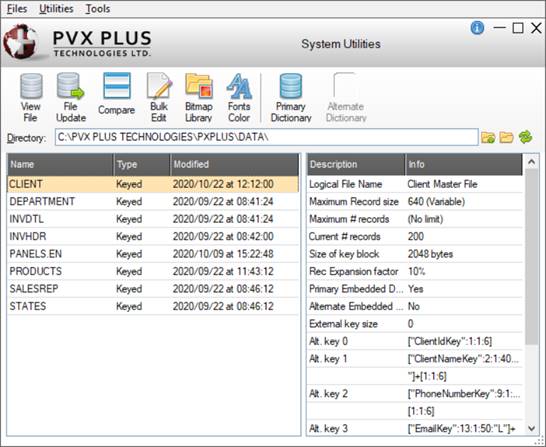
|
System Utilities |
|
PxPlus comes equipped with several utilities that are not, strictly speaking, part of the language, but provide various design, configuration, maintenance and diagnostic services within the development environment. These utilities are actually separate programs that reside as auxiliary files in the PxPlus system sub-directory, Lib. All of the utilities are installed with the PxPlus base system, but some were originally designed for use in a character-based environment, some apply to a graphical (Windows) system only, and some require a thorough understanding of PxPlus internal code and may not be available for general use. The majority of system utilities are intended for the creation, debugging, and management of PxPlus programs, files, and directories. See Development Tools.
The System Utilities window provides access to the graphical utilities. Graphical utilities are available for systems running PxPlus for Windows or via WindX. They have all the capabilities of the classic character-based utilities plus access to a few features that are specific to graphical and Web-based development environments; i.e. *IT - Integrated Toolkit and Ed+ program editor.
To invoke this window, use one of the following methods:
|
Location |
Method |
|
From the PxPlus IDE Main Launcher |
Select System Utilities from the PxPlus IDE category. |
|
From the NOMADS Session Manager |
Select Utilities > System from the menu bar. |
|
From the PxPlus Command line |
Type: gui |
The System Utilities window is displayed:
This window consists of the following:
|
Directory |
Initially displays the full pathname of the current working directory. To display the files for a different directory, select the Directory Browse button (beside the Directory field) or manually enter the full pathname. |
|
(Move Up) |
Button used for moving up one directory. |
|
(Directory Browse) |
Button used for changing to a different directory. |
|
(Refresh) |
Button used for refreshing the list of files displayed in the left pane. |
|
(Left pane) |
Lists the available files in the displayed directory, along with the file name, type and time stamp details. |
|
(Right pane) |
Displays additional details about the file selected in the left pane. This information is dependent on the type of file: program, data file, link reference or device. |
These options are listed in the order that they appear on the menu bar: Files, Utilities and Tools.
|
Description | |
|
List Open Files |
Launches a separate window with a list of open files that can be sorted by file number, type, record size, key length, pathname and Keyed/Indexed information. |
|
Exit |
Closes the System Utilities window. |
|
Displays a drop-down menu of system utilities, grouped into categories: Files, Directories, Programs, Configuration and General. | |||||||||||||||||||||||||
| |||||||||||||||||||||||||
| |||||||||||||||||||||||||
| |||||||||||||||||||||||||
| |||||||||||||||||||||||||
|
|
Description | |
|
Calendar |
Launches a Calendar popup. |
|
Calculator |
Launches the Calculator. |
|
Program Editor |
Launches the default program editor, which is typically the *IT - Integrated Toolkit. To use Ed+ as the default program editor instead, change the setting for the NOMADS Program_Editor property to Ed+. This can be done by using the NOMADS Environment Maintenance utility. (The ability to set Ed+ as the default program editor was added in PxPlus 2023.) |
|
Notepad |
Launches Notepad. |
The following tool bar options provide convenient access to commonly used functions that are also available as Menu Bar Options:
|
Tool Bar Option |
Description |
|
View File |
Launches the File View Utility for viewing (not modifying) the contents of a selected data file, if applicable. Can also be accessed from Utilities > Files > View on the menu bar. |
|
File Update |
Launches the File Update Utility for viewing, modifying and updating the contents of a selected data file, if applicable. Can also be accessed from Utilities > Files > Update on the menu bar. |
|
Compare |
Launches the Program Compare Utility. Can also be accessed from Utilities > Programs > Compare on the menu bar. |
|
Bulk Edit |
Launches the Bulk Program Scan/Edit Utility. Can also be accessed from Utilities > Programs > Bulk-Edit on the menu bar. |
|
Bitmap Library |
Launches the Bitmaps library. See Displaying Bitmaps/Icons. Can also be accessed from Utilities > General > Display Bitmaps on the menu bar. |
|
Fonts Color |
Launches the Available Fonts and Colors window for specifying Font/Size, Foreground/Background colors, and attributes such as Bold, Italics, and Underscore All Characters. Can also be accessed from Utilities > General > Display Font and Colours on the menu bar. Click the Color Query button to access Color Selections. Valid formats for color selections include predefined system colors (e.g. Light Red), Custom (RGB codes), HTML Hex Color Codes, User Defined colors (e.g. Color17) and string Expressions. (The Color Selections Query button and dialog were added in PxPlus 2020.) |
|
Primary Dictionary |
(Available when the selected file is a PxPlus data file with a primary/alternate embedded data dictionary) Launches the View Embedded Dictionary window for viewing the file layout details. |
NOMADS (Non-procedural Object Module Application Development System) is an integrated suite of utilities that simplify the development of graphical user interface based applications using PxPlus.
NOMADS allows you to separate data access, logic and graphical controls into reusable segments, localize changes, design a graphical front-end for character-based components and create event-driven applications. The toolset includes a common data manager for consistent access to a variety of data files, as well as a generic error-handling interface.
For an introduction to graphical user interface development in PxPlus, see Graphical User Interfaces.